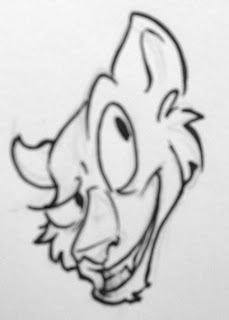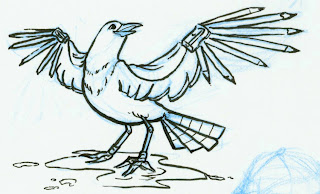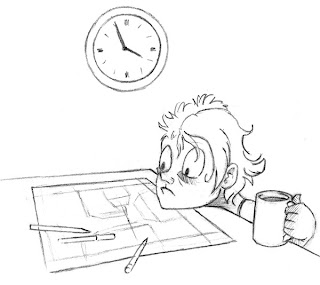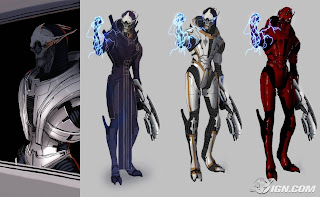Because my response to the last question mentioned a few different areas of art, I decided this question from the list would be the best to answer next.
Q: "What are the different fields of art you can go into?"
This is an excellent question, as most people don't realize just how vast the topic of "art" is. Categorizing fields of art can be a little difficult, but I'll do my best.
Fine Art - Everyone knows fine art. You go to a museum and there's paintings all over the wall. You visit a park and there's a statue of some long-dead soldier riding a horse. This is fine art. It's a broad field, but fine art can generally be defined as pieces of work often made in traditional mediums, created for the sole purpose of being placed on display for people to enjoy. Fine art is usually a painting, a sculpture, or a drawing. It's difficult to make money doing fine art, but because of this, I find that fine artists have an incredible amount of passion for what they do, and they simply live for their art.
Illustration - There's some cross over between illustration and fine art. Illustrations are usually drawn or painted (traditionally or digitally), but they specifically serve the purpose of telling a story of some kind. Illustrators learn how to tell story through their images by using composition, color, and lighting to their advantage. Illustration is most often used for books, but there is some crossover into concept art for film, and comics (or graphic novels) could be considered a branch of illustration.
Concept Art for Film- Concept artists are the creative minds behind everything you see on the movie (or TV) screen. They do the initial design for the characters, environments, monsters, props, vehicles, and costumes of every fantasy, sci-fi, action, horror, or animated film you've seen. They draw hundreds of designs for every detail for the director to choose from. Most of that art ends up on the drawing room floor, but it's all for the sake of creating the best designs possible for the final product.
Concept Art for Video Games - Same as for film, but game artists often have to design even more detail than film artists, because they are designing an entire 3D world for the player to explore. That soldier that just slaughtered you in PvP had to be designed by someone!
Storyboarding - (This is my major!) Storyboards are used to plan every action, camera angle, and camera movement of a movie, animation, video game, or commercial. These are then used as guides for the animators and/or director for actually creating the final product. The quality of the final product relies on the storyboards to display good character acting, composition, and timing.
Animation - There are three types of animators - 2D, 3D, and stop motion. 2D is the traditional method of hand-drawn animation, like Cinderella or The Lion King. 3D animation is created using 3D models in a computer, like Toy Story or Kung Fu Panda. Stop motion is made with physical puppets animated in front of a camera, like Nightmare Before Christmas and ParaNorman. Though the mediums are very different, every animator needs to learn the
12 Principles of Animation in order to make their character feel alive to the audience.
3D Modeling/Rigging - Modelers create 3D models of characters, props, and environments on the computer to be used in films or video games. A rigger is then given the job of creating all the joints and moving parts for those 3D models. These jobs are most often given to two separate people, but I lumped them together because modelers and riggers have to work so closely.
Stop Motion Fabrication - Stop motion is a small industry right now, but fabrication is a BIG job. Fabricators build the physical puppets, sets, and props for stop motion films. These people have to know sewing, carpentry, and a huge variety of craft skills in order to make everything needed for a stop motion film.
I think that's enough of fields of art in film. Let's look at something completely different.
Fashion Design - Fashion designers sketch out concepts for outfits, decide what does or doesn't work, then create the outfit by hand. While the popular fashion designs to publicize are dresses, fashion designers will design any and all kinds of clothing. The clothes you're wearing right now started as a simple concept sketch in a fashion designer's sketchbook.
Graphic Design - Graphic designers create logos, choose the fonts and layout of a product label, or design the whole look for a website. Graphic design is another broad topic, but graphic designers often work freelance, hired only for single projects by a business client.
Industrial Design - This is an even broader topic. Industrial designers can specialize in vehicles, buildings, household appliances, or personal electronics, just to name a few. Generally, industrial design is a combination of art and engineering. An industrial designer's job is to create something that is both functional and visually appealing.
Photography - This one is pretty straight forward. Photographers take photos. However, they don't always simply take pictures of pretty landscapes to hang in galleries. Nature photographers will travel across the world simply to get rare shots of exotic animals. Product photographers specialize in getting the most appealing shot of a company's product - from iPones to Big Macs. Fashion photographers take photos specifically to show off the latest outfits in a fashion magazine. There are a lot of options in photography.
This is really only scratching the surface and generalizing a lot of information, but I think this post is already huge enough.
You know the drill. Any questions or requests to know more, leave a comment!
(Disclaimer: I own none of the images in this post. All images are copyright their original owners)





















































